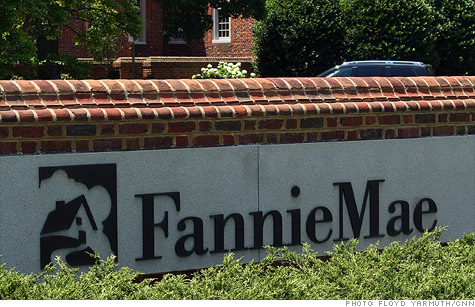Search News

Fannie Mae did not need additional bailout funds in the first quarter.
NEW YORK (CNNMoney) -- Mortgage backer Fannie Mae reported the best quarterly results since before the housing meltdown, saying it did not need additional billions in tax funds for the quarter and that it believes losses on past mortgages peaked at the end of last year.
The company also reported just enough profit in the three months ended March 31 to cover its latest payment to the Treasury Department, and predicted better profits ahead.
The first quarter earnings of $2.7 billion before that payment was the best net income since the $4.3 billion Fannie made in second quarter of 2004. That was in the midst of the housing bubble, when rising home sales and prices contributed to the company's profits until the market collapsed three years later.
Fannie attributed the better results to a slowing in the decline in home prices, a drop in its inventory of foreclosed homes and better sale prices for the foreclosed homes it sold.
"We expect our financial results for 2012 to be significantly better than 2011," said Susan McFarland, Fannie's chief financial officer, in the earnings statement released Wednesday.
There have been numerous signs of improvement in the long-battered housing market in recent months, as record-low mortgage rates, low home prices and lower unemployment have helped to draw home buyers back into the market. But the large supply of foreclosed homes for sale have continued to depress home prices.
Fannie and Freddie provide most of funds used for U.S. home mortgages, as they purchase and bundle loans made by banks and other lenders, attach loan guarantees, and then sell or hold securities backed by those mortgages. As of March 31, the two companies guaranteed $3.06 trillion in home loans.
When the housing bubble that inflated in the last decade burst in 2007, the drop in home prices and the spike in foreclosures caused huge losses for the two firms.
In the summer of 2008, Congress essentially agreed to cover those losses, concerned that if they were to go out of business, home buying would cease and financial markets would seize up. Treasury stepped in to place both companies under conservatorship, which is similar to bankruptcy.
Since then, Fannie has received $116.1 billion in bailout funds. It has made $22.6 billion in dividend payments back to Treasury, including $2.8 billion in the most recent quarter. The result was a net cost to taxpayers of $93.5 billion.
Freddie Mac has received $72.3 billion from the Treasury, and paid back dividends of $18.3 billion. It needed $19 million from Treasury at the end of the first quarter, after making a $1.8 billion dividend payment.
There have been quarters in this period when Fannie would have been profitable if not for the large dividend payments and the payment from Treasury was simply being used to make the dividend payment back to the government. That was the case for Freddie in the first quarter.
Before the dividend payment, Fannie reported net income in the quarter of $2.7 billion, compared to a net loss of $6.5 billion a year earlier. ![]()